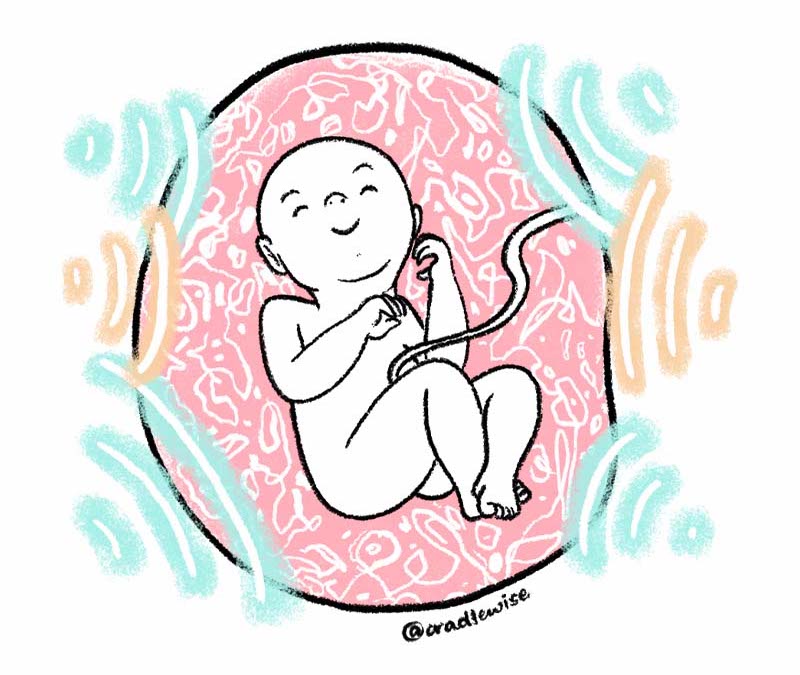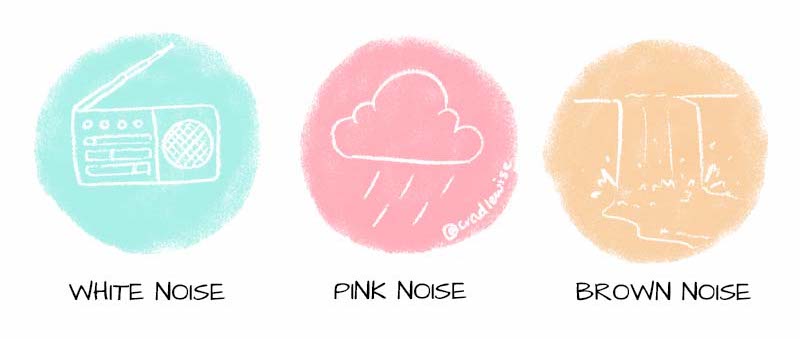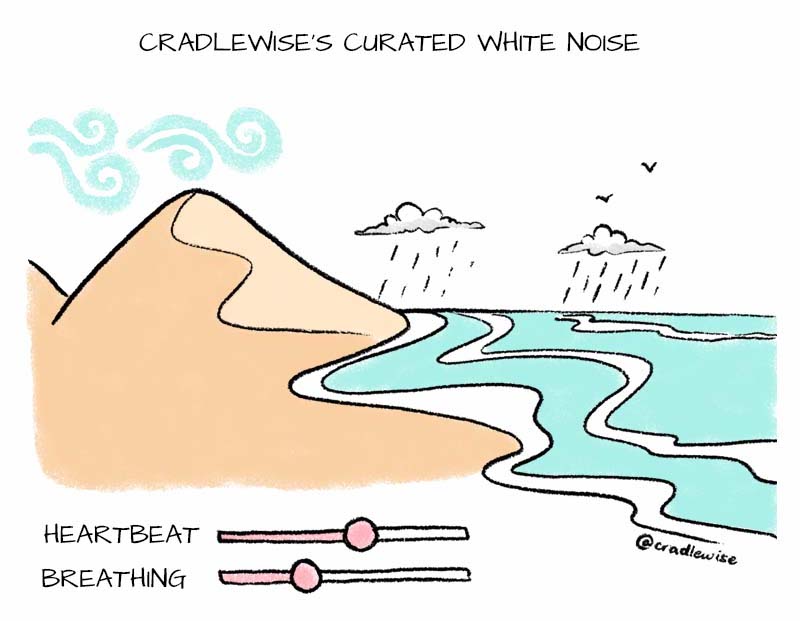Science of baby sleep
0 min read
The science of sound and baby sleep

Cradlewise Staff
As parents, we’re always looking for ways to optimize our bedtime routine to help our babies sleep better. A time-honored bedtime routine for babies often includes reduced exposure to bright lights a few hours before bed, a bath, a story, and music that helps them drift to dreamland.
Music has played an essential role in babies’ bedtime routines throughout history. Every culture, country, and language has its own lullabies that parents sing to their babies at bedtime. Not only do music and lullabies help your baby sleep, but they also play a crucial role in your baby’s language and speech development.
So let’s dive into the science of sound and baby sleep, understanding how different types of sound help your baby sleep, and how you can use Cradlewise’s sound settings to replicate those sounds.
The first sounds of your baby’s life

Your baby’s hearing is one of the first senses that develop in utero. In fact, unlike their other senses, their ability to hear is fully developed when they’re born!
Your little one’s hearing develops at 20 weeks gestation, when you’re five months pregnant. At around 23 weeks, they are capable of detecting loud noises from outside—the music you might be listening to in the living room or even the sound of your voice. Your baby might even hiccup or kick in response to a loud noise.
For nine months, your baby lives in a world where they can connect with the world outside purely through the sounds they hear. So, in a way, the first connection your baby forms with the outside world is through sound and music.

Did you know?
Scientists have found that babies can identify familiar voices after birth—so encourage your baby’s older siblings and family members to “talk” to the baby during pregnancy!
How do different types of sound help babies sleep?
Babies rely heavily on external stimuli to calm themselves and sleep. In the first few months of life, babies typically sleep 16 to 17 hours per day, and different types of soothing sounds and music can help them fall asleep and stay asleep longer.
As babies grow from newborn to toddler, their sensory experiences, sleep patterns, and cognitive development change, leading to shifts in the types of sounds that can help them fall asleep.
1. Newborn stage
Since your baby’s hearing develops in the womb, the first sounds they hear are your heartbeat, breathing, the rush of blood flowing in your body, and the rumble of your digestive system.
They also hear your and your partner’s voices, along with any music you play to them or other environmental noises. These noises are the sound of home for your baby.
When they’re born, the comparative silence of being outside the womb, as well as the bombardment of different sounds and stimuli, can all be daunting to adjust to.
To help your baby fall asleep, you can use pink or white noise machines, since they replicate the noises babies hear in the womb.
These sounds can help calm a newborn’s nervous system, which can be overstimulated by the new world they are experiencing. Newborns also benefit from rhythmic sounds, such as a heartbeat.
2. Four to six months
Babies become more aware of their surroundings and develop preferences for specific sounds as they grow. At three to six months, they begin recognizing their caregivers’ voices more clearly.
Around this age, babies may be soothed by familiar voices, such as their parent’s voice, or simple melodies.
Music with a slower tempo or a lullaby melody can help a baby relax and fall asleep. Some babies may also respond well to environmental sounds such as rainfall, light wind, or ocean waves.
3. Seven to twelve months
Babies become more mobile between seven and twelve months and start exploring their environment. They may become more sensitive to sudden, loud noises that could startle them awake.
As a result, sounds that can help soothe them to sleep need to be more consistent and rhythmic. White noise or gentle nature sounds, such as birdsong or rustling leaves, can be particularly helpful at this age.
4. Toddlerhood
As babies become toddlers, their preferences for sounds may become more individualized. Some toddlers prefer to fall asleep with a favorite song or bedtime story, while others enjoy white noise or nature sounds.
At this stage, listening to the child’s cues and adjusting the sounds is important. Toddlers especially benefit from a consistent bedtime routine, including a specific sequence of sounds or activities that signal their sleep time.
Different sounds for baby sleep

Many parents wonder which sounds or music might help their baby fall asleep faster and stay asleep.
However, there’s no one-song-soothes-all answer to this question, since every baby is unique, and they develop their own preferences as they grow. Some babies might feel drowsy when listening to Mozart, while others might like a lullaby.
That said, there are some common sounds and music that often help soothe babies to sleep:
- White noise: White noise is a type of noise that contains all audible frequencies in equal amounts. Some examples of white noise around us are TV or radio static, the gentle hum of a ceiling fan or air conditioner, or even a vacuum cleaner.
White noise can help mask other noises in the environment and create a calming atmosphere for your baby.
- Pink noise: Pink noise is similar to white noise but gentler. It can sound like a gentle, soothing waterfall, steady rainfall, waves crashing on a beach, or wind rustling through tree leaves.
Recent research confirms that the noises that babies hear inside the womb closely resemble pink noise, making it perfect for newborn babies to sleep to.
- Lullabies: You can sing lullabies to your little one to soothe them. The rhythm of lullabies often mimics the swinging or rocking motion babies experience in your womb, which helps them fall asleep faster.
So whether you sing “Rock-a-bye Baby,” “Twinkle, Twinkle, Little Star,” or “Brahms’ Lullaby” to your little one, the sound of your voice will soothe them and help them quickly fall asleep.
- Bedtime stories: The sound of your voice and reading bedtime stories to your baby can also help them fall asleep, while supporting their language skills and introducing new concepts.
If you’re wondering what’s the right time to start reading to your baby, the answer is—it’s never too early! While some experts recommend that you start reading to your baby while they’re still in the womb, you can begin any time.
- Instrumental tracks: Instrumental tracks can also be an excellent option for soothing your baby. Choose music with soft melodies and gentle rhythms, and avoid anything too loud or complex. Examples of instrumental tracks include piano music, harp music, and classical guitar music.
- Classical music: Classical music can be particularly soothing for babies. Studies have shown that listening to classical music can help lower blood pressure and reduce stress. Choose pieces with a slow tempo and a gentle melody, such as Clair de Lune by Claude Debussy or Canon in D by Johann Pachelbel.
- Nature sounds: Many pink, white, and brown noise tracks include nature sounds, like rain, wind, and ocean waves.
However, you can also use different tracks, like the sounds of birds chirping or a river running its course. These sounds can create a peaceful environment and help mask other sounds.
Cradlewise’s sound settings

We know that music and sounds are important for developing your baby’s brain, language skills, and ability to express their feelings through words, among other things. Keeping this in mind, we’ve built sound features into your baby’s crib to soothe, comfort, and engage them.
The Cradlewise smart bassinet and crib comes with a built-in sound machine, saving you a trip to the store to buy a white noise machine for your baby’s nursery.
Our sound machine has white, pink, and brown noise sleep tracks. You can also customize these tracks by layering soothing sounds, like heartbeat, breathing, waves, and rain.
For example, when your baby is in the newborn stage, you can choose a pink noise track and layer it with the sound of breathing and heartbeat. This will recreate the sound of being in the womb for your baby.
To customize a sleep track:
- Tap on the Sound icon on your bottom navigation bar. In the Sound tab, select the (+) from the top right corner.
- Choose white, pink, or brown noise.
- Choose your preferred ambiance of light rain, heavy rain, soft breeze, or waves.
- Add a subtle sound of heartbeat and/or breathing as per your preference.
- Use the ‘Preview on crib’ button to preview and change your mixed composition to your preference.
- Give your track a name and tap on Save.
Cradlewise also has a Spotify integration feature that enables you to pair your crib with the Spotify app and then use it as a speaker for your baby. Using this feature, you can create a Spotify playlist of your baby’s songs, instrumental tracks, lullabies, and nursery rhymes and use your smart crib as a giant speaker.
More posts you might like:
You may also like



